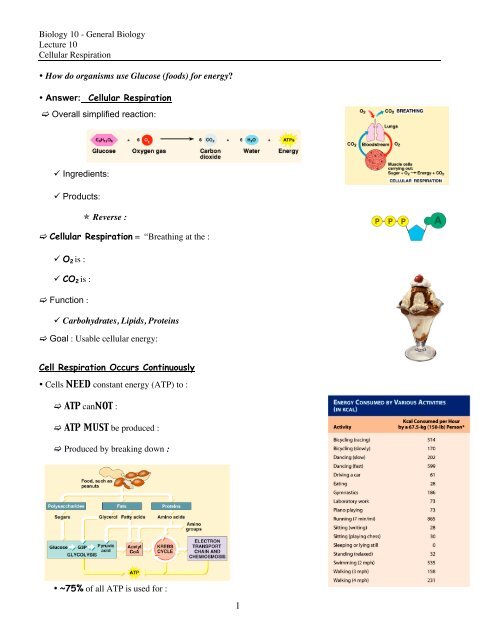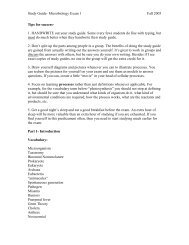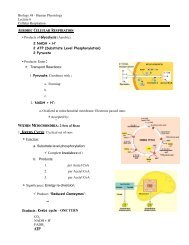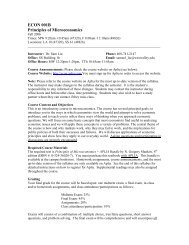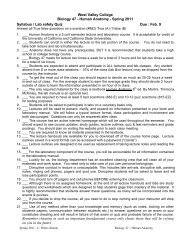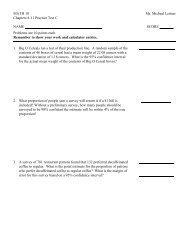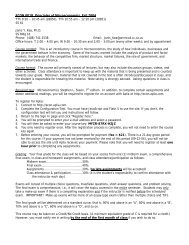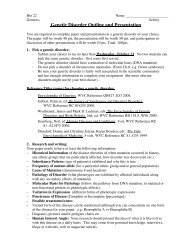Biology 10 - General Biology Lecture 10 Cellular Respiration • How ...
Biology 10 - General Biology Lecture 10 Cellular Respiration • How ...
Biology 10 - General Biology Lecture 10 Cellular Respiration • How ...
You also want an ePaper? Increase the reach of your titles
YUMPU automatically turns print PDFs into web optimized ePapers that Google loves.
<strong>Biology</strong> <strong>10</strong> - <strong>General</strong> <strong>Biology</strong><br />
<strong>Lecture</strong> <strong>10</strong><br />
<strong>Cellular</strong> <strong>Respiration</strong><br />
<strong>How</strong> do organisms use Glucose (foods) for energy?<br />
Answer: <strong>Cellular</strong> <strong>Respiration</strong><br />
Overall simplified reaction:<br />
Ingredients:<br />
Products:<br />
Reverse :<br />
<strong>Cellular</strong> <strong>Respiration</strong> = “Breathing at the :<br />
O2 is :<br />
CO2 is :<br />
Function :<br />
Carbohydrates, Lipids, Proteins<br />
Goal : Usable cellular energy:<br />
Cell <strong>Respiration</strong> Occurs Continuously<br />
<strong>•</strong> Cells NEED constant energy (ATP) to :<br />
ATP canNOT :<br />
ATP MUST be produced :<br />
Produced by breaking down :<br />
<strong>•</strong> ~75% of all ATP is used for :<br />
1
Basal Metabolic Rate: Energy needed to :<br />
<strong>•</strong> ATP also used for :<br />
2 Methods of <strong>Cellular</strong> <strong>Respiration</strong><br />
Cal /day or (Kcal/day)<br />
1. Aerobic <strong>Respiration</strong> : Hybrid Vehicle<br />
<strong>•</strong> Uses :<br />
<strong>•</strong> Most efficient method of :<br />
40% transferred into :<br />
60% lost as :<br />
<strong>•</strong> Location:<br />
1 glucose =<br />
2. Anaerobic <strong>Respiration</strong>: Hummer<br />
<strong>•</strong> “NO :<br />
<strong>•</strong> Inefficient method of using:<br />
2% transferred into:<br />
38% remain in :<br />
60% lost as :<br />
1 glucose =<br />
<strong>•</strong> Occurs w/in :<br />
2 Methods of Cell <strong>Respiration</strong>:<br />
1. ANAEROBIC:<br />
<strong>•</strong> Glucose Breakdown without<br />
<strong>•</strong> Reaction:<br />
Glucose: 6 Carbon Molecule<br />
a. Cut into two:<br />
Animal cells:<br />
Unicellular Organisms:<br />
2
.<br />
<strong>•</strong> Disadvantages:<br />
1. ONLY 2 ATP per glucose<br />
<br />
2. Produce TOXIC bi-product<br />
<br />
Causes muscle :<br />
Ethanol<br />
Death to :<br />
<strong>•</strong> Advantage:<br />
Can continue to produce ATP when :<br />
<strong>•</strong> Process also called :<br />
2. Aerobic <strong>Respiration</strong>:<br />
Multi-step process: Requires<br />
Three sets of Chemical reactions:<br />
a. Glycolysis<br />
b. Krebs Cycle<br />
c. Electron Transport Chain<br />
Complete breakdown of GLUCOSE into:<br />
a. Energy in glucose converted into:<br />
b. Waste:<br />
c. Waste:<br />
3
Oxygen’s Role in Aerobic <strong>Respiration</strong>:<br />
Oxygen used in last set of reactions<br />
<br />
Electron transport chain produces :<br />
a. Electrons are removed from :<br />
b. Electrons are passed :<br />
c. Electrons :<br />
d. Electrons removed from chain by :<br />
O2 + e- + H + → H2O<br />
We breath in order to efficiently use nutrients for energy (ATP)<br />
Energy Demands : Important Points<br />
1. Energy Storage:<br />
Energy stored in :<br />
2. Energy Use:<br />
Carbohydrates (sugars), fats, protein<br />
ATP cannot be :<br />
ATP is an on :<br />
ATP must be made through continued :<br />
3. ONLY Glucose can be used without :<br />
<br />
4. FATS & PROTEINS require :<br />
<br />
Energy Content :<br />
Fats : Kcal / gram<br />
Proteins : Kcal / gram<br />
Carbo’s : Kcal / gram<br />
4
Study Questions :<br />
1. What do organisms do with the glucose they either make (like plants) or ingest (like us)?<br />
2. What is the only usable molecular form of energy within the cell?<br />
3. What multi-step set of reactions do cells use to interconvert nutrients (ie glucose) and ATP?<br />
4. What is the overall simplified cellular respiration reaction? What is the overall goal of cellular respiration? <strong>How</strong><br />
does it relate to photosynthesis?<br />
5. Can cells store ATP? Does cellular respiration need to occur constantly in a living organism? <strong>How</strong> do you<br />
know this to be true (hint : think of the need for oxygen by living organisms)<br />
6. What is the basal metabolic rate? Approximately how many calories is the average human basal metabolic<br />
rate?<br />
7. What can you do to increase the amount of calories you are using during the day?<br />
8. What are the two methods or strategies of cellular respiration? Which method of respiration is more effective at<br />
capturing the energy in the bonds of ATP?<br />
9. Where does the carbon dioxide that we exhale come from?<br />
<strong>10</strong>. What molecule must be present for aerobic cellular respiration to occur?<br />
11. <strong>How</strong> efficient is aerobic cellular respiration at capturing the energy in glucose into the energy in the bonds of<br />
ATP (<strong>How</strong> many ATP are made)? <strong>How</strong> efficient is anaerobic cellular respiration at capturing the energy? In what<br />
form is most of the energy “lost”?<br />
12. What is lactic acid? When is lactic acid formed? What are some of the problems with lactic acid and ethanol?<br />
What is the advantage of anaerobic cellular respiration?<br />
13. Where does anaerobic cellular respiration occur?<br />
14. Where does aerobic cellular respiration occur?<br />
15. Can cells use organic molecules other than glucose for energy? Which organic molecules require oxygen to be<br />
used? Which organic molecule can be used anaerobically?<br />
16. What are the three reaction of aerobic cellular respiration?<br />
17. <strong>How</strong> is oxygen used in the electron transport chain? What does oxygen form when it combines with the<br />
electrons and hydrogen?<br />
18. Why is it important that we breathe oxygen? Why do cells die very quickly when oxygen is not present?<br />
19. Which organic molecule contains the greatest amount of energy per gram?<br />
20. If you wanted to loose weight by specifically burning fat would it be best to run or walk? Why?<br />
21. Describe the relationship between photosynthesis and cellular respiration. (look at the above diagram)<br />
5


